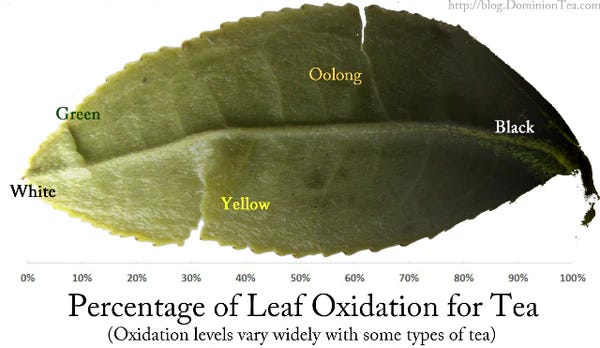Source: Milky Print
Hello September! Not only does it mark the start of the school year (which means a much needed healthy supply of caffeine), but it’s also AUTUMN woohoo~ It’s the season to jump into pretty piles of leaves, pull out the warm sweaters, and stay cozy at home with a cup of tea and a good book. Falai loves trying out different kinds of tea and organizing her collection of tea at home.
To welcome this fall season, let’s brew a pot of tea and talk about these leaves, shall we? In this post, we will cover:
How tea was first discovered
Different kinds of tea
Where we get our tea from (literally, no pun intended)
Different types of tea beverages
🍃 How was tea first discovered?
According to legend, tea was accidentally discovered by Chinese Emperor Shen Nong around 2737 BCE. While he was boiling water in the garden, some leaves from a nearby wild tea tree blew into his pot. As he sipped the tea, he found the tea infusion flavorful and refreshing!
Source: Red Leaf Tea
Ancient records also show that tea cultivation and consumption began in China, where tea was used as a medicinal herb before becoming a beverage that people consume in their everyday lives. The practice spread to Japan and other parts of Asia before reaching Europe and the rest of the world.
🍃 What are the different kinds of tea?
There are many different types of tea which differ in their processing methods and oxidation levels. Oxidation refers to the chemical reaction when tea leaves are exposed to oxygen, which can change the color and flavor of the tea.
Source: Only Foods
White tea is the least processed of all teas, and made from young tea leaves and buds that are simply withered and dried.
Green tea is made from tea leaves that are quickly pan fried to prevent oxidation, which lends it its grassy flavor.
Oolong tea falls between both green tea and black tea, where it is partially oxidized in terms of color and flavor. Because this balance is carefully controlled in the process, it has complex notes in its flavor profile. Oolong derives its name from the Chinese characters 烏龍 (pronounced as wulong), which means “black dragon”. This is because oolong tea leaves are black, long and curled up, like a dragon!
Source: Bruu Tea
Finally, black tea is at the far end of the spectrum, where it is fully oxidized, with a stronger, more robust flavor profile. This is not to be confused with fermented tea, such as pu-erh and rooibos tea, where tea undergoes an aging process. The aging process can differ.
Ripe pu-erh for example, is where tea is aged naturally with microbial action and oxidation overtime. Meanwhile, raw pu-erh involves putting tea into a pile, spraying them with water, and letting them sit for a while in a humid space. Then, they are packed together into discs called tea cakes. The different aging processes lead to different flavors, where raw pu-erh is more floral and refreshing, whilst ripe pu-erh is more earthy.
Pu-erh (普洱) actually got its name from its place of origin, which is a city located in the Yunnan province of China. With its mountainous terrain and warm subtropical climate, it creates good conditions for growing tea and has become a trading post where all teas from nearby mountains are sold and traded.
Then, there is also herbal tea, which involves using herbs and flowers like rose, mint, and lavender, and also tea blends, where you mix different kinds of teas and herbs together to create an infusion you like!
🍃 So if I leave green tea out in the air, does it turn into black tea?
Nope! Oxidizing tea is a comprehensive process that involves many steps.
After harvesting tea, the tea leaves are withered to reduce the moisture content. The tea leaves are gently crushed by hand or machine, and rolled further to break the cell walls. This prepares the tea leaves for the oxidation process so that it exposes the leaf’s inner tissues to the air.
Oxidation then happens in a controlled environment where the temperature and humidity are monitored. Depending on the desired tea type, they are left to oxidize for a certain period, from a few hours, a day or longer.
Once the desired level of oxidation is achieved, the tea leaves are heated to stop the oxidation process and to lock in the flavors. This can involve steaming, pan frying or baking in an oven.
Source: Bruu Tea
🍃 What tea do we use for our milk tea?
We source our tea leaves from a local family-run business, Arbor Teas. We love how their tea is fair-trade certified, and the packaging they use is compostable.
For our milk tea, we use a combination of pu-erh tea, and ceylon or assam black tea. Both ceylon and assam black tea taste and look very similar. But there is a difference. Ceylon tea is produced in Sri Lanka, and has a more refreshing taste, whilst assam black tea is produced in the Assam region of India, and tastes more earthy, robust and malty.
🍃 What are other kinds of tea beverages apart from Hong Kong milk tea?
There are so many! We found this fun illustration from Booky that lists some of them, such as teh tarik, masala tea, and Thai tea. There are also tea cocktails (or mocktails) that you can conjure up, like an oolong martini, a London fog drink which uses earl grey, or even tea desserts like a matcha tiramisu.
Source: Booky
🍃 What tea do YOU drink?
That’s the end of this post! Let us know what your favorite tea is. We would love to know tea brands you would recommend, or even tea-based recipes that we could try!
Till next time!











